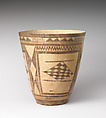Beaker with a checkerboard design
Not on view
Burials in the large cemetery at the important site of Susa in southwestern Iran have yielded a great number of very finely made vessels in the shape of tall, flaring cups, usually called beakers. Like much of the pottery from Iran in the Chalcolithic Period (ca. 5500-3000 B.C.), this piece is very skillfully made, with thin walls and highly-fired, fine clay. It may have been created or finished using a tournette, the precursor to the potter’s wheel, which is a flat disc balanced on a central pivot that can be spun with one hand while the other hand is used to smooth and shape a pot in the center of the wheel. The beaker is decorated with a combination of geometric designs painted in dark brown on cream-colored ceramic. It is clear that the arrangement of motifs was carefully planned, with the vessel’s outer surface divided into upper and lower borders combining lines of varying thickness with triangular shapes and what may be rows of birds in flight along the upper edge, framing large rectangular sections within which checkerboard diamond shapes are centered, bordered at top and bottom by a row of dots in a line. Delicate pottery is fragile and breaks easily, and it appears that this beaker broke and was subsequently repaired in the ancient past. At several points on the beaker, a pair of holes have been drilled on either side of a break, and were likely strung together by some sort of textile or leather strips to hold the broken pieces together. The people who used this beaker must have placed a high value on it, as demonstrated by their efforts to repair rather than simply discard it, the typical fate of most broken ancient pottery.
Due to rights restrictions, this image cannot be enlarged, viewed at full screen, or downloaded.
This artwork is meant to be viewed from right to left. Scroll left to view more.



